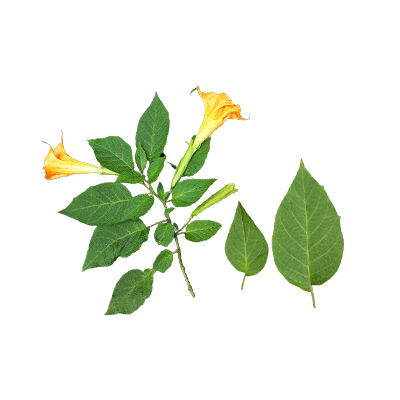Angel's Trumpet
Brugmansia suaveolens (Humb. & Bonpl. ex Willd.) Sweet
Solanaceae
Location in our garden
Principal



Synonym
Datura arborea Mart.
Datura gardneri Hook.
Datura suaveolens Humb. & Bonpl. ex Willd.
Habitus
Shrubs. A semi-woody shrub or small perennial tree that grows to 1.8-4.6 m high.
Part Used
Leaves
Flowers
Growing Requirements
Full Sunshine
Habitat
Wetland
Riverbanks
Forest
Overview
Brugmansia suaveolens is native to tropical and southern America. It is invasive in parts of Kenya, and naturalised in Uganda and in Tanzani These plants are grown for ornamental use and many are unaware of its toxic nature as in this case. Angel's trumpet is a popular garden plant. It is grown for its showy and attractive bloom. It can be smoked, eaten, drunk as a tea, or taken as an enema. In Tanzania it is added to beer. Traditional healers use the dried leaves of B. suaveolens added to tobacco to induce diagnostic visions for treating various diseases. In Sri Lanka, it has been used in the past to sedate sacrificial victims in spiritual ceremonies.
Vernacular Names
Attana (Sinhalese-Sri Lanka).
Agroecology
Brugmansia suaveolens occupies lowland rainforest, forest edges, disturbed habitats, riverbanks and urban open spaces. It grows in organically rich, medium moisture, well-drained soils in full sun. During the growing season, plants are heavy feeders that need regular fertilization to stimulate new growth and flowers. Annual mean temperature needed is 15-25 ºC, with annual mean rainfall is 500-2,500 mm.
Morphology
- Stem - many branched, single trunk.
- Leaves - oval in shape, up to 25 cm long and 15.2 cm wide, and even larger when grown in the shade.
- Flowers - sweetly fragrant, about 30 cm long and shaped like trumpets. The corolla has five points that are slightly recurved. The flowers are usually white but may be yellow or pink and are pendulous, hanging almost straight down.
- Fruit - a capsule.
- Seed - grey in colour.
Cultivation
Generative propagation is by seed, and vegetatively propagated by cuttings.
Chemical Constituents
Alkaloids (scopolamine, atropine and hyoscyamine), saponin, scopholamine, glycoside, flavonoid, and polyphenols.
Traditional Medicinal Uses
- It has antiinflammatory actiivity, and anticholinergic effect.
- In Sri Lanka, it has been used as an anaesthetic agent for external use.
Part Used
Reference Sources
- Bionet Eafrinet. (2011). Brugmansia suaveolens (Angel's Trumpet). https://keys.lucidcentral.org/keys/v3/eafrinet/weeds/key/weeds/Media/Html/Brugmansia_suaveolens_(Angels_Trumpet).htm. 05-03-2022.
- CABI. (2022). Invasive Species Compendium: Brugmansia suaveolens (Angel's trumpet). https://www.cabi.org/ISC/abstract/20127801912. 05-03-2022.
- Jayawickreme, K.P., Janaka, K.V.C., and Subasinghe, S.A.S.P. (2019). Unknowing ingestion of Brugmansia suaveolens leaves presenting with signs of anticholinergic toxicity: a case report. Journal of Medical Case Reports, 13: 322. doi: 10.1186/s13256-019-2250-1.
- Kew Royal Botanic Gardens. (2021). Plants of the World Online: Brugmansia suaveolens. https://powo.science.kew.org/taxon/urn:lsid:ipni.org:names:77109576-1. 05-03-2022.
- Missouri Botanical Garden (No date). Brugmansia suaveolens. https://www.https://www.missouribotanicalgarden.org/PlantFinder/PlantFinderDetails.aspx?taxonid=287209. 05-03-2022.


